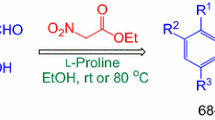Conclusions
-
1.
Electron-donor substituents in the p-positions of the aromatic rings in Schiff bases increase the overall addition rate of the benzoyl and trichloroacetyl isocyanates to Schiff bases and shift the reaction toward the formation of 4-membered rings, whereas electron-acceptor substituents shift the reaction toward the formation of oxidiazinone derivatives.
-
2.
Highly polar solvents (dimethyl sulfoxide and SO2) promote the formation of hexahydro-S-triazine-dione derivatives.
Similar content being viewed by others
Literature cited
B. A. Arbuzov and M. Kh. Mannanov, Izv. Akad. Nauk SSSR, Ser. Khim., 617 (1970).
J. Firl and S. Sommer, Tetrahedron Lett., 1925 (1970).
J. Firl and S. Sommer, Tetrahedron Lett., 1929 (1970).
R. Richter, Chem. Ber.,102, 938 (1969).
H. Ulrich, B. Tucker, F. A. Stuber, and A. A. R. Sayigh, J. Org. Chem.,34, 2250 (1969).
F. Duran and L. Ghosez, Tetrahedron Lett., 245 (1970).
Author information
Authors and Affiliations
Additional information
Translated from Izvestiya Akademii Nauk SSSR, Seriya Khimicheskaya, No. 9, pp. 2016–2020, September, 1972.
Rights and permissions
About this article
Cite this article
Zobova, N.N., Rusanov, G.N. & Arbuzov, B.A. Reaction of isocyanates with schiff bases. Russ Chem Bull 21, 1957–1960 (1972). https://doi.org/10.1007/BF00854615
Received:
Issue Date:
DOI: https://doi.org/10.1007/BF00854615




